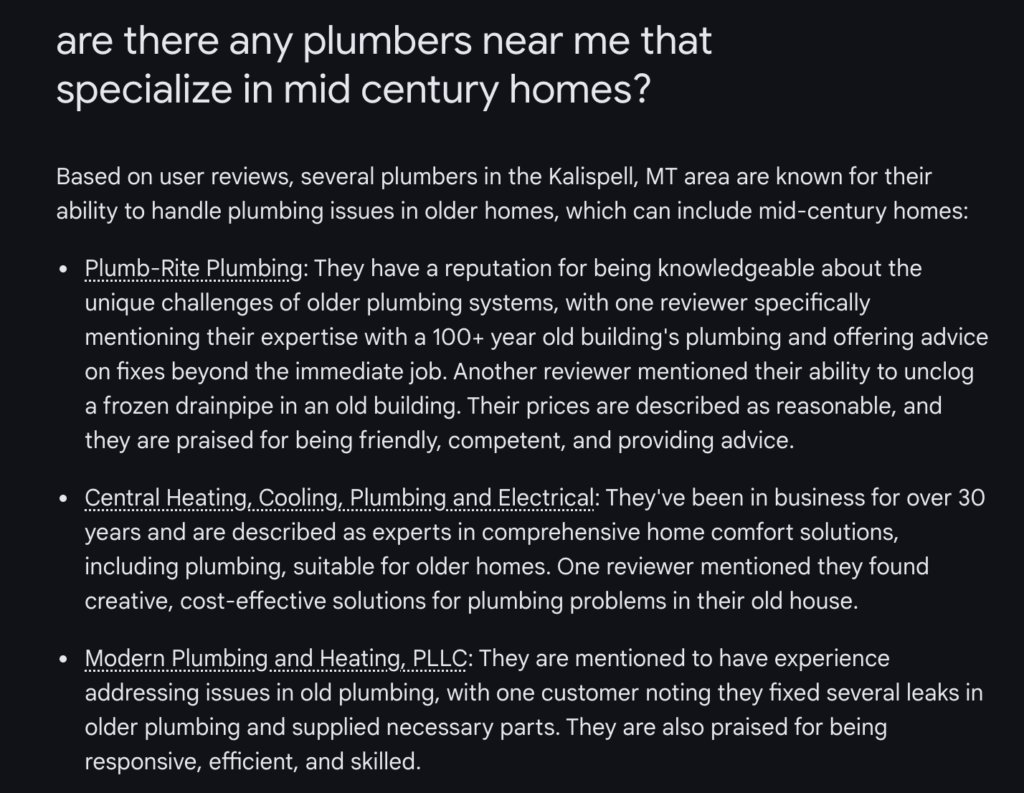The way customers discover local businesses is undergoing a fundamental transformation. Google’s aggressive push toward AI-driven search results, from AI Overviews to the new AI Mode, signals a seismic shift in how we need to think about local visibility. Meanwhile, ChatGPT’s browser mode and other AI platforms are creating new pathways for customer discovery that bypass traditional search entirely.
For local business owners, this isn’t a distant future concern. It’s happening now, and the businesses that adapt quickly will gain a significant competitive advantage over those still optimizing for yesterday’s search landscape.
Understanding Google’s AI Search Evolution
Google has introduced two primary AI-powered search features that are reshaping local discovery:
AI Overviews generate custom results by synthesizing information from multiple sources to answer user questions directly. While local map results still appear prominently for basic business searches, customers are increasingly seeing AI Overviews that provide comprehensive information to help them choose between options quickly. These overviews include an option to “explore further in AI Mode,” creating a gateway to deeper conversational search.
AI Mode represents the future of search interaction. Instead of typing “plumbers near me” and then clicking through multiple websites to find one that specializes in older homes, customers can now ask, “Are there any plumbers near me that specialize in mid-century homes?” AI Mode pulls from website content, customer reviews, and business information to provide specific, conversational answers that save users significant time and effort.
This shift toward conversational, context-aware search means that businesses need to fundamentally rethink how they present information online. The days of keyword-stuffed content are ending. AI search rewards natural, helpful information that directly answers customer questions.

The Information Sources AI Platforms Trust
Just like traditional Google search, AI platforms prioritize information from reputable, consistent sources. However, they’re particularly effective at synthesizing information across multiple touchpoints to create comprehensive answers. This means your business information needs to be:
- Consistent across all platforms (Google Business Profile, website, social media, review sites)
- Detailed and conversational in tone
- Rich with specific examples and use cases
- Regularly updated with fresh, relevant content
When someone asks an AI assistant about local services, the AI pulls from your website content, customer reviews, business listings, and other public information to form its response. If your information is incomplete, inconsistent, or generic, you’ll be overlooked in favor of competitors who’ve invested in comprehensive, helpful content.
5 Strategic Steps to Dominate AI Search
1. Maintain Bulletproof Business Information Consistency
AI systems are particularly sensitive to conflicting information. If your business name appears differently across platforms, or your hours vary between your website and Google Business Profile, AI assistants may exclude you from results or provide incorrect information to potential customers.
Action Steps:
- Audit your business information across Google Business Profile, Apple Maps, Bing, Yelp, Facebook, and industry-specific directories
- Implement a system for keeping this information synchronized
- Update all platforms immediately when business details change
- Use tools like Yext or BirdEye to automate consistency across platforms
2. Implement Advanced Structured Data
Schema markup makes your business information machine-readable for AI systems. While this technical element has always been important for SEO, it’s become critical for AI discovery.
Essential Schema Types:
- LocalBusiness schema with complete NAP (Name, Address, Phone)
- Service area markup for businesses that travel to customers
- FAQ schema for common questions
- Review schema to showcase customer feedback
- Event schema for businesses that host events
This structured data helps AI platforms accurately interpret and cite your content when responding to user queries.
3. Build a Proactive Review Generation System
Customer reviews have evolved beyond social proof. They’re now primary content sources for AI platforms. When someone asks about a business’s specialty or quality, AI assistants frequently reference specific review content to provide detailed, contextual answers.
Strategic Review Approach:
- Automate review requests via SMS or email after service completion
- Ask specific questions that encourage detailed responses about the customer’s situation
- Respond to all reviews quickly (within 24 hours when possible)
- Address negative reviews constructively to improve overall sentiment
- Encourage customers to mention specific services, neighborhoods, or unique situations
The goal is generating reviews like: “Hill Media Group completely transformed our restaurant’s online presence. Before working with them, we barely showed up when people searched for ‘family restaurants in downtown.’ Now we’re getting calls from families specifically looking for our kids’ menu and outdoor seating options.”
4. Create Conversational, Question-Answering Content
AI search rewards content that matches how people naturally speak and ask questions. This means shifting from keyword-focused content to conversation-focused content that directly addresses customer concerns.
Content Strategy for AI Search:
- Develop comprehensive FAQ sections using natural language
- Create service pages that answer specific customer scenarios
- Include location-specific content that addresses local needs and challenges
- Write in a conversational tone that mirrors how customers would ask questions
- Add high-quality images with descriptive alt text for visual search compatibility
Instead of a generic “plumbing services” page, create content like: “Common Plumbing Problems in Historic Homes” or “Emergency Plumbing Services Available 24/7 in Kalispell.”
5. Monitor and Adapt to AI Platform Performance
The AI search landscape changes rapidly, and businesses need systems for tracking their visibility and accuracy across platforms.
Monitoring Strategy:
- Test how your business appears on ChatGPT, Google’s AI Mode, Bing Copilot, and other AI platforms
- Search for your business name, category, and location combinations monthly
- Check for accuracy in AI-generated responses about your business
- Document and correct any errors or inconsistencies quickly
- Stay informed about new AI search features and adjust strategies accordingly
The Competitive Advantage Window
Local businesses that implement these strategies now will establish themselves as authoritative sources before AI search becomes the dominant discovery method. The businesses that wait will find themselves playing catch-up in an increasingly competitive landscape where AI platforms have already formed preferences for information sources.
This transition mirrors the early days of Google search, when businesses that invested in websites and basic SEO gained massive advantages over competitors who waited. The difference is that this AI search revolution is happening much faster.
Why Professional Implementation Matters
While the strategies above are clear, implementing them effectively requires expertise in technical SEO, content strategy, and local search optimization. A skilled SEO agency can:
- Generate dozens of natural, question-answering content pieces that address specific customer scenarios
- Implement proper schema markup and technical optimizations
- Build comprehensive review generation and management systems
- Monitor AI platform performance and adapt strategies as the landscape evolves
- Ensure all efforts align with broader digital marketing goals
The businesses that dominate AI search won’t be those with the largest budgets; they’ll be those with the most comprehensive, helpful, and consistently presented information. By taking action now, local businesses can secure their position in the AI-driven future of customer discovery.
The question isn’t whether AI search will become dominant; it’s whether your business will be ready when it does.




